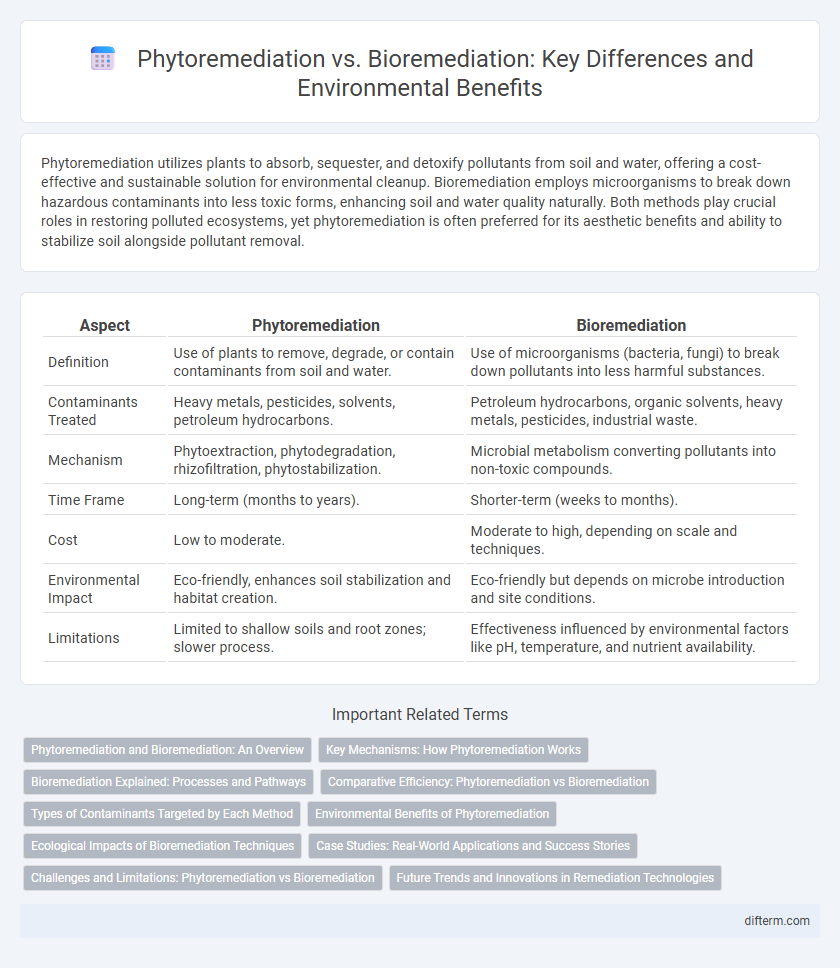Phytoremediation utilizes plants to absorb, sequester, and detoxify pollutants from soil and water, offering a cost-effective and sustainable solution for environmental cleanup. Bioremediation employs microorganisms to break down hazardous contaminants into less toxic forms, enhancing soil and water quality naturally. Both methods play crucial roles in restoring polluted ecosystems, yet phytoremediation is often preferred for its aesthetic benefits and ability to stabilize soil alongside pollutant removal.
Table of Comparison
| Aspect | Phytoremediation | Bioremediation |
|---|---|---|
| Definition | Use of plants to remove, degrade, or contain contaminants from soil and water. | Use of microorganisms (bacteria, fungi) to break down pollutants into less harmful substances. |
| Contaminants Treated | Heavy metals, pesticides, solvents, petroleum hydrocarbons. | Petroleum hydrocarbons, organic solvents, heavy metals, pesticides, industrial waste. |
| Mechanism | Phytoextraction, phytodegradation, rhizofiltration, phytostabilization. | Microbial metabolism converting pollutants into non-toxic compounds. |
| Time Frame | Long-term (months to years). | Shorter-term (weeks to months). |
| Cost | Low to moderate. | Moderate to high, depending on scale and techniques. |
| Environmental Impact | Eco-friendly, enhances soil stabilization and habitat creation. | Eco-friendly but depends on microbe introduction and site conditions. |
| Limitations | Limited to shallow soils and root zones; slower process. | Effectiveness influenced by environmental factors like pH, temperature, and nutrient availability. |
Phytoremediation and Bioremediation: An Overview
Phytoremediation leverages specific plants to absorb, degrade, or sequester contaminants from soil, water, and air, making it a cost-effective and eco-friendly method to restore polluted environments. Bioremediation employs microorganisms such as bacteria and fungi to biologically degrade hazardous substances into less toxic forms, enhancing soil and water quality. Both techniques utilize natural processes to remediate contaminants, with phytoremediation excelling in heavy metal uptake and bioremediation being effective against organic pollutants.
Key Mechanisms: How Phytoremediation Works
Phytoremediation harnesses plants to remove, degrade, or stabilize contaminants through processes like phytoextraction, phytodegradation, phytostabilization, and phytovolatilization. Root systems absorb heavy metals and organic pollutants, while plant enzymes metabolize toxic compounds into less harmful forms. This method is environmentally sustainable, cost-effective, and capable of restoring soil and water quality by leveraging natural plant-microbe interactions.
Bioremediation Explained: Processes and Pathways
Bioremediation involves the use of microorganisms such as bacteria, fungi, and algae to degrade or transform hazardous contaminants in soil, water, and air into less toxic forms through metabolic processes. Key pathways include aerobic degradation, where oxygen-dependent microbes break down organic pollutants, and anaerobic degradation, which involves bacteria functioning in oxygen-free environments to remediate compounds like chlorinated solvents and heavy metals. The efficiency of bioremediation depends on factors such as temperature, pH, nutrient availability, and the presence of appropriate microbial consortia tailored to specific contaminants.
Comparative Efficiency: Phytoremediation vs Bioremediation
Phytoremediation uses plants to extract or degrade contaminants, making it cost-effective and sustainable, especially for heavy metals and persistent organic pollutants in soil and water. Bioremediation, involving microbes, accelerates the breakdown of organic pollutants such as hydrocarbons and pesticides with higher metabolic versatility and faster contaminant degradation rates. While phytoremediation is limited by slow plant growth and bioavailability of toxins, bioremediation offers greater efficiency in diverse environmental conditions but may require stringent monitoring to maintain microbial activity.
Types of Contaminants Targeted by Each Method
Phytoremediation primarily targets heavy metals, pesticides, and petroleum hydrocarbons through plant uptake, accumulation, and degradation processes. Bioremediation effectively eliminates organic pollutants such as polycyclic aromatic hydrocarbons (PAHs), chlorinated solvents, and industrial waste by utilizing microbial metabolism. Both approaches address specific contaminant classes, with phytoremediation excelling in soil and sediment treatment, while bioremediation is preferred for liquid and mixed-phase contaminants.
Environmental Benefits of Phytoremediation
Phytoremediation harnesses plants to remove, stabilize, or degrade contaminants such as heavy metals, pesticides, and organic pollutants from soil and water, offering a sustainable and eco-friendly solution. This method enhances soil health by promoting microbial activity, reducing erosion, and improving biodiversity without the use of harmful chemicals. Its cost-effectiveness and ability to restore ecosystems in situ make phytoremediation a valuable tool for long-term environmental recovery and pollution mitigation.
Ecological Impacts of Bioremediation Techniques
Bioremediation techniques utilize microorganisms to degrade pollutants, significantly reducing soil and water contamination while preserving the native ecosystem's balance. This method enhances biodiversity by restoring habitats without introducing non-native species or chemicals, thus maintaining ecological integrity. Compared to phytoremediation, bioremediation can more rapidly detoxify hazardous substances, minimizing long-term ecological risks and promoting sustainable environmental recovery.
Case Studies: Real-World Applications and Success Stories
Phytoremediation has been successfully applied in sites like the Chernobyl Exclusion Zone, where sunflowers and willow trees absorbed radioactive contaminants from soil and water. Bioremediation demonstrated effective cleanup at the Exxon Valdez oil spill in Alaska, utilizing microbial populations to degrade hydrocarbons in marine environments. Case studies highlight phytoremediation's cost-efficiency in heavy metal removal and bioremediation's versatility in breaking down diverse organic pollutants.
Challenges and Limitations: Phytoremediation vs Bioremediation
Phytoremediation faces limitations such as slow plant growth rates, seasonal dependency, and restricted application to shallow soil or surface water contamination. Bioremediation challenges include maintaining optimal microbial activity, the presence of toxic compounds inhibiting microbes, and difficulty treating complex pollutant mixtures in heterogeneous environments. Both methods require site-specific assessment to overcome issues related to contaminant bioavailability and environmental conditions impacting remediation efficiency.
Future Trends and Innovations in Remediation Technologies
Phytoremediation leverages plants for contaminant uptake and stabilization, offering a cost-effective and sustainable approach to soil and water remediation with innovations in genetic engineering enhancing plant tolerance and degradation capabilities. Bioremediation utilizes microorganisms to break down pollutants, showing significant advancements through synthetic biology and microbial consortia engineered for accelerated degradation of complex contaminants. Emerging trends emphasize integrating sensor technologies and AI-driven monitoring systems to optimize remediation efficiency and real-time assessment of environmental restoration progress.
phytoremediation vs bioremediation Infographic

 difterm.com
difterm.com